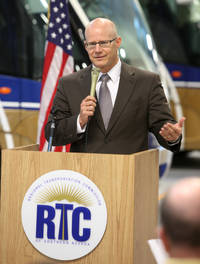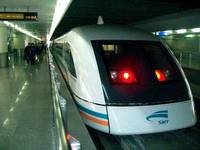Alliance pushes high-speed train corridor
Fri, Dec 18, 2009 (3 a.m.)
A newly created alliance of local transit agencies will try to persuade federal authorities that stimulus money should be used on high-speed rail corridor studies, a move that could put Las Vegas back on the map as a railroad town.
The Western High-Speed Rail Alliance wants the Federal Railroad Administration to fund a key portion of President Barack Obama’s transportation strategy: the development of a nationwide high-speed train network.
Meanwhile, in a separate development, backers of high-speed rail systems in Japan spoke at UNLV to show interest in providing its technology for systems built in the United States.
The Railroad Administration’s plan for high-speed rail includes corridors in California, the Pacific Northwest and east of the Mississippi River, but nothing in the Intermountain West. The alliance contends that Western cities such as Phoenix, Las Vegas, Salt Lake City and Denver will be among the fastest growing in the next few decades and should be connected with high-speed rail.
Jacob Snow, general manager of the Las Vegas-based Regional Transportation Commission of Southern Nevada and chairman of the alliance, said local transit agencies need to take the lead on developing high-speed passenger rail because the most difficult part of the planning is the final miles to bring a line into a city.
Snow and other members of the four-state alliance held in an Internet news conference last week. Snow and Tom Skancke, a Las Vegas-based transportation consultant, have been the driving forces for forming the alliance, which includes representatives from the Utah Transit Authority, the Denver Regional Council of Governments, the Washoe County Regional Transportation Commission and Arizona’s Maricopa Association of Governments.
Skancke said the alliance is in the process of incorporating as a nonprofit organization that would approach federal agencies for money to develop a high-speed rail network that would tie into planned rail lines across the country.
The alliance is important to Las Vegas because the city is a key hub in the regional network. A rough route map presented by Skancke at a meeting of the North Las Vegas Chamber of Commerce in October showed routes linking Las Vegas with Phoenix and Salt Lake City as priorities. Other priority routes include Phoenix to Los Angeles, Salt Lake City to Denver and Salt Lake City to Reno.
The alliance has acknowledged a route linking Las Vegas with Los Angeles is a high priority that is being pursued by competing private interests. Snow said the Regional Transportation Commission has met regularly with the developers of DesertXpress and the American Magline Group, which want to build lines between Las Vegas and Southern California. The commission is neutral in its support of DesertXpress, which plans a traditional high-speed rail, or American Magline, which backs magnetic-levitation transport.
At the Dec. 9 news conference, Snow said he is pleased that Obama has made high-speed rail a priority, but he thinks multistate approaches to building a national rail network are key to its success, just as the interstate highway system was developed.
Alliance members say they have been working with their state transportation departments to get them to understand the organization’s concepts.
The group has been talking with the Railroad Administration on freight lines. Separating passenger and freight lines would benefit both systems. Snow said he is open to discussions with other states to expand the alliance. He has been in contact with California, New Mexico and Idaho, which have shown interest in the organization’s goals.
On Dec. 7, the Central Japan Railway Co., operator of the famed Shinkansen “bullet train,” told an audience at UNLV it is interested in bringing its technology to the United States. The presentation was the fourth in a series of high-speed rail forums sponsored by UNLV’s Transportation Research Center and the Ward 5 Chamber of Commerce.
Two high-speed proposals are in different stages of development. The traditional steel-wheel DesertXpress would connect Las Vegas to Victorville, Calif., has completed an environmental-impact statement on its proposed route, and managers have said construction would begin on the $4 billion project in next year’s first quarter.
American Magline Group, would use magnetic levitation technology with a route that would go to Anaheim, Calif. The maglev is at least a year behind DesertXpress, and the company estimates it would cost $12 billion to build.
The Central Japan Railway is on the outside looking in on the existing proposals because DesertXpress has partnered with Canada-based Bombardier as its primary supplier, while American Magline is working with Transrapid of Germany, which has a commercially operating maglev in Shanghai.
Tsutomu Morimura, senior executive director and director general of the technology division of the Central Japan Railway, said his company has patented anti-derailing guard rails and post-derailment stoppers on tracks to help prevent trains from coming off their tracks in an earthquake.
Morimura said the Shinkansen is on its fifth generation design and the N700-I model the company is pitching worldwide has a maximum cruising speed of 205 mph — 55 mph faster than the DesertXpress.
But Morimura said operators of trains in Southern California and Southern Nevada should pay attention to earthquakes and take measures to prevent derailments.
Central Japan Railway, based in one of the most earthquake-prone regions in the world, has conducted vibration tests on high-speed-rail bogies and developed track enhancements to head off derailments.
High-speed myths / Business plan shows deceit of bullet train push
FRIDAY, DECEMBER 18, 2009 AT MIDNIGHT
Thirteen months ago, California voters bamboozled by a governor with an edifice complex and a swooning media made one of their dumbest decisions in recent memory. They gave narrow approval to Proposition 1A, a $9.95 billion bond billed as a one-time-only taxpayer “down payment” on a $34 billion high-speed rail system linking Northern and Southern California. The rest of the funding was supposed to come from the private sector and the federal government.
Bullet trains are a cool concept that have proven popular – if very expensive – in other parts of the world. But the bold promises made by Arnold Schwarzenegger![]() and the rest of the pro-1A camp for California’s version went beyond outlandish to preposterous.
and the rest of the pro-1A camp for California’s version went beyond outlandish to preposterous.
Advocates said annual ridership would be so enormous – 117 million – that the project would become massively profitable and would have vast environmental and traffic benefits by getting tens of thousands of polluting vehicles off the state’s roads. Ridership would be so voluminous that economies of scale would hold the cost of trips from Los Angeles to San Francisco to just $55 and that 450,000 non-transportation-related jobs would be created as a result.
There was just one problem: The ridership figure that was central to all these claims was seemingly invented out of whole cloth. The entire Amtrak![]() system, which has more than 500 destinations in 46 states, has but 26 million passengers a year. The 117 million estimate was also vastly inflated from rail advocates’ own initial estimates – almost certainly because an honest estimate would have been a harder sell.
system, which has more than 500 destinations in 46 states, has but 26 million passengers a year. The 117 million estimate was also vastly inflated from rail advocates’ own initial estimates – almost certainly because an honest estimate would have been a harder sell.
The grotesqueness of this exaggeration was widely known in fall 2008. Beyond this fundamental problem, a Reason Foundation study assisted by Joseph Vranich, a former president of the High Speed Rail Association, exposed basic errors in speed and safety claims.
The governor didn’t care. Neither, amazingly, did much of the state media. The same editorial pages that are now deeply and appropriately worried about the state’s dangerously high levels of bond debt in many cases backed high-speed rail.
Now, finally, California High-Speed Rail Authority officials are being forced to discuss their project more honestly. An updated business plan released this week scraps several ridiculous claims in favor of somewhat or slightly less ridiculous claims. The San Francisco-Los Angeles fare is now projected to be $105, not $55. Annual ridership is now expected to be 41 million, not 117 million.
But other key claims endure – especially the daffy assertion that 450,000 non-transportation-related jobs would be created by the train system. And an absolutely crucial finding in the updated plan was glossed over. It noted that private investors were very wary to risk their money without an additional “clear public funding commitment” – which can only be interpreted as a demand that the project have so much taxpayer money in it that it becomes, yes, too big to fail.
Meanwhile, a new report says California’s freeways rank 49th among the states in pavement condition.
What’s wrong with this picture? Everything.



No comments:
Post a Comment